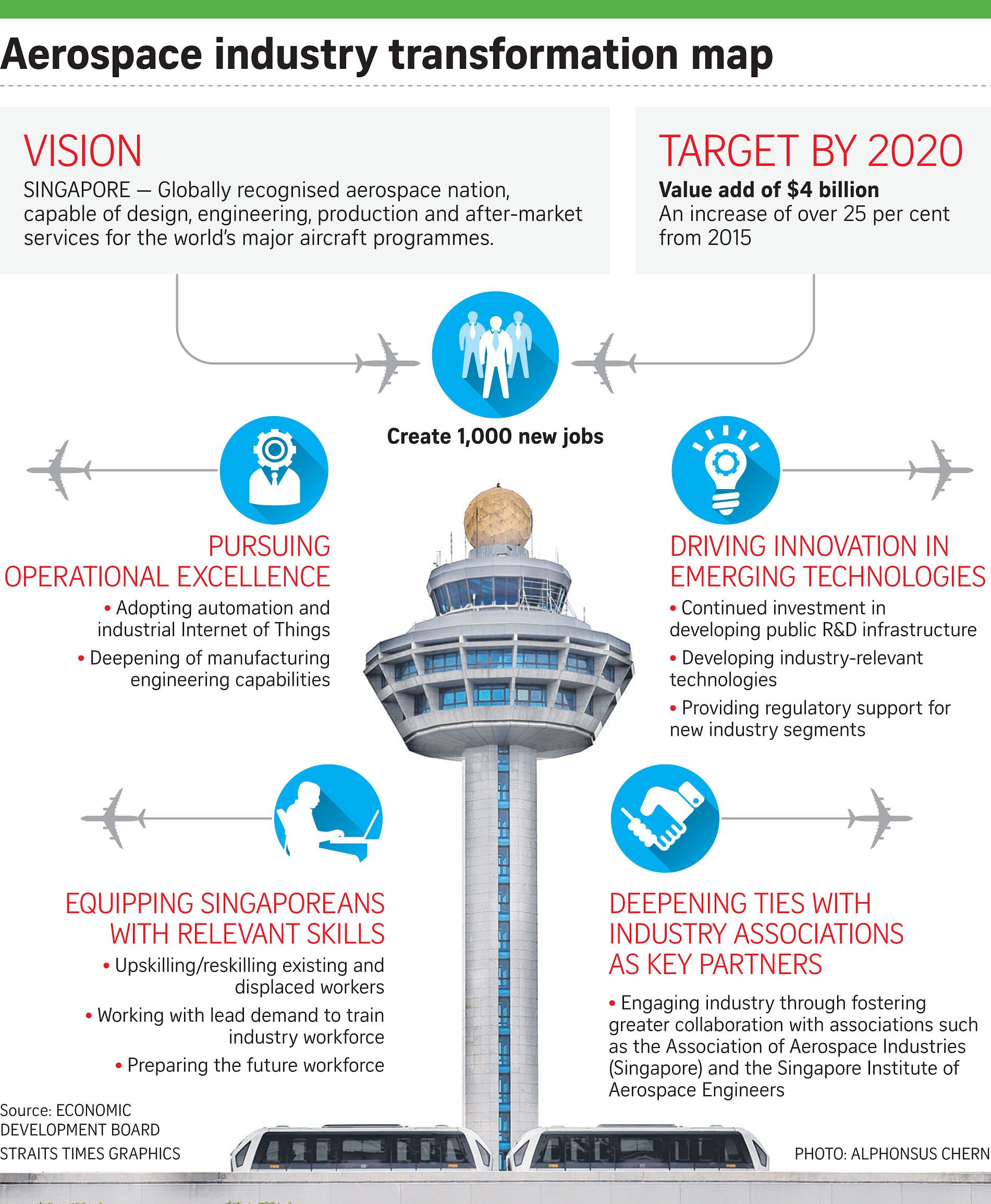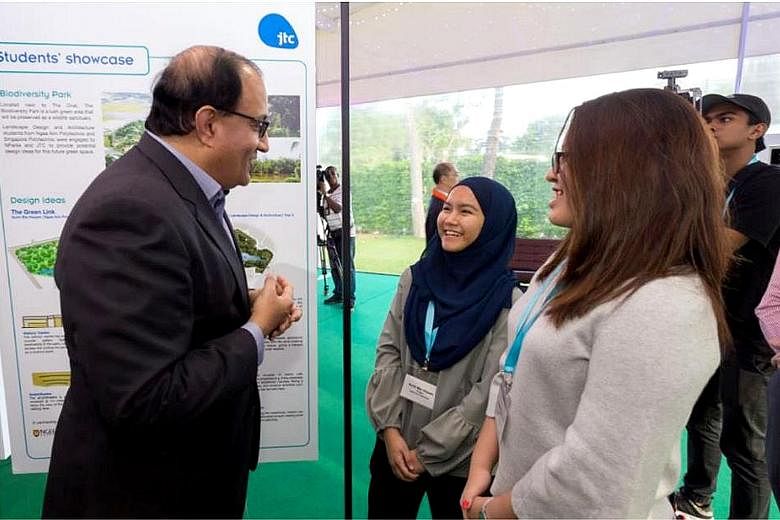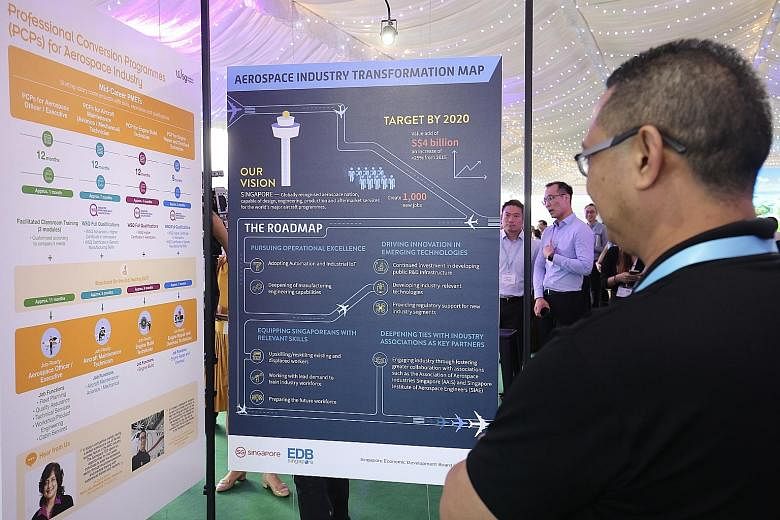An aerospace industry transformation map (ITM) that could create 1,000 new jobs by 2020 and add $4 billion in value to manufacturing in the sector has been launched.
Developed by a multi-agency team together with industry partners, unions and trade associations, the ITM maps out strategies to build an aerospace industry catering for the future.
Minister for Trade and Industry (Industry) S. Iswaran launched the ITM in line with the 10th anniversary of Seletar Aerospace Park, which will be having a series of student outreach initiatives to groom future talent, and new phases of development.
The ITM has identified three key areas: pursuing operational excellence, driving innovation in emerging technologies, and equipping Singaporeans with relevant skills.
One way it will help improve productivity is through assisting local aerospace company, Singapore Aerospace Manufacturing, to invest in advanced automation equipment as well as software and engineering capabilities that will upgrade existing lines to manufacture next-generation aircraft components.
Another initiative by the Economic Development Board (EDB) and the Agency for Science, Technology and Research will encourage the development of industry-relevant technologies that can be brought onto the market in the coming years, the EDB said in a press statement yesterday.
Possible focus areas in the collaboration include industrial Internet of Things, additive manufacturing, data analytics for predictive maintenance and asset optimisation.

To help implement changes in the aerospace industry, the Government also aims to deepen ties with industry associations here, including the Association of Aerospace Industries (Singapore) and the Singapore Institute of Aerospace Engineers.
"The Aerospace ITM, like all other ITMs, is focused on the needs and challenges of the industry, especially the SMEs who are a major part of our economy," Mr Iswaran said, adding that ITMs are "integral to our efforts to transform our economy and drive long-term growth".
Key components of the aerospace ITM that he highlighted were ideas and feedback from the industry, the labour movement and other stakeholders, including the Aerospace ITM Forum and Aerospace Industry Tripartite Committee.
Mr Iswaran said the initiatives in the ITM are not set in stone and "must respond to a dynamic economic environment".
"The development and implementation of the ITM must be keenly attuned to industry trends, and its various initiatives must adapt and (be) continually refined to help our enterprises respond quickly and effectively to changing economic conditions."
The aerospace ITM is the 17th of 23 maps that the Government has earmarked. The remaining maps are expected to be launched by March. The 23 ITMs will cover 80 per cent of the economy.
The introduction of ITMs was first announced in Budget 2016.
Yesterday, the EDB said the aerospace industry is a key sector of growth for the Singapore economy, with an average annual growth rate of 7 per cent in value-add over the past 20 years.
It added that Singapore has continued to maintain its status as the Asia-Pacific's leading maintenance, repair and overhaul hub, contributing to 10 per cent of the global aerospace industry's output for the sector .
Industry transformation maps not static but adaptable: Iswaran
The industry transformation maps (ITMs) rolled out by the Government are not static plans but need to adjust to changing conditions, Minister for Trade and Industry (Industry) S. Iswaran said yesterday.
"If there's a need to modify, maybe even change fundamentally some aspects, that's something we have to do.
"The environment we are operating in is such a fast-changing one. It will not do to have static plans," Mr Iswaran told reporters on the sidelines of the launch of the aerospace sector's ITM.
"Some of the other ITMs were launched more than a year back and the environment has already shifted, like in retail... (They) are already revisiting to see what else they need to do and where they need to make changes."
To date, 17 ITMs have been launched, with the rest expected to be rolled out by March.
While the ITMs have found broad support from businesses, there have been concerns that they may not be responsive enough to new trends, and that many smaller companies are not fully aware of how the programmes can help them transform their operations.
Mr Iswaran said: "I think it's important that SMEs and SME bosses make the effort to understand what is available out there and if they don't understand, find out." This is where trade associations, industry associations and chambers of commerce have a key role to play in raising awareness of ITMs.
"They understand the programme, and we're talking about a base of 180,000 SMEs. You really need these trade associations and chambers as opinion multipliers who can take the message to the ground and activate the response from that broad base."
Mr Iswaran added that the programmes, including skills development, are being designed and communicated to reach out, in particular to the SME community. "It's important we don't see this as a government initiative alone because it is really an initiative that needs to be owned by all parties," he said.
Using the Committee on the Future Economy as an example, he said more than three-quarters of the members were from the private sector, and it was "not by accident but (by) design".
"We recognise that the trends are such that we need industry players on board with us because they have their finger on the pulse in terms of what's happening."



